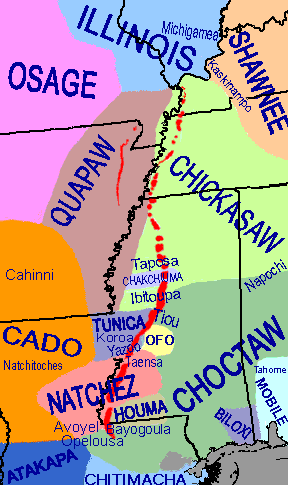
Accompanying the December, 1972 issue of National Geographic magazine was a fascinating map. Entitled "Indians of North America," it covered all of North America, from the Panama-Columbia border to Alaska and Greenland. The map oriented us by saying that "When Columbus reached the new World, between 6 and 60 million people, speaking some 550 languages, inhabited the area covered by this map." The map at the right has been redrawn from a small section of that map. Names in UPPER CASE are major tribes or nations, while those in small case are minor ones.
Our map shows where various Indian tribes were known, or believed, to have existed at the very beginning of North America's historical period -- when Europeans began arriving here in significant numbers.
Here and there on the larger National Geographic map, tribal names clustered like flies around a drop of honey. One such location was the Copper Canyon area of southern Chihuahua, Mexico, with a terrain so rugged that small groups of people occupying only one or two valleys were able to evolve culturally for centuries without outside disturbance, eventually constituting distinct tribal units. Another spot on the map thick with many tribes was the Pacific Northwest, where a combination of bountiful sea life and towering forests supported a diversity of cultures. A yet third cluster of tribes was clearly delineated right here in our Loess Hills. Our map shows this cluster surrounded by larger tribes.
Why should so many Indian tribes cluster in our Loess Hills?
For one thing, the Loess Zone is high land next to very fish- and wildlife-rich lowland and rivers. It must have been very special to have access to fish and beaver, but not to have to live in the swamps, and deal with frequent flooding and so many mosquitoes.
Second, the loess zone, as we see elsewhere in this site, is mantled with nutrient-rich soil serving as a basis for an exceptionally rich ecosystem -- more wildlife, more varied roots, berries, and better farming possibilities than in similar upland environments.
Finally, our Hills don't suffer through the long winters experienced farther north, yet there are enough cold snaps during our brief winter to keep diseases from building up as they do in tropics.
Chickasaw, Taposa, Chakchiuma, Ibitoupa, Tiou, Tunica, Ofo, Yazoo, Taensa, Natchez, Houma... they seem to have been fairly lucky to live in our Loess Hills, and indications are that they were doing fairly well for themselves... until the Europeans arrived...